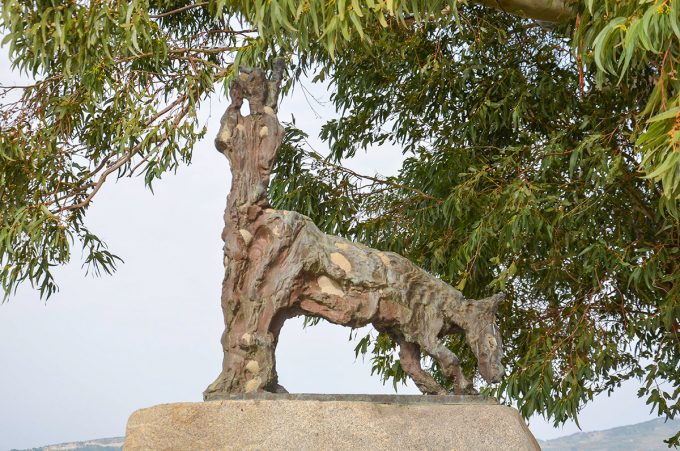Art and history, at first glance two separate, parallel but divided paths, sometimes show themselves as much more united and interconnected, confirming a simple truth: art as an expression of historical memory. Every painting, every sculpture, every poem, every work of art in general represents a unique and always different form of remembering, changing only in expressive language. This fusion in a superb synthesis of history and art, of the real and the ideal, is expressed perfectly by Ugo Foscolo with an interpretation of the word poetic, which “is not subject to material laws, so its harmony can challenge the centuries, can win the silence to which human works are destined, preserving the memory for the eternity”.
Can art have the function of warning, of spiritual and emotional remembrance? Yes of course. The forms of artistic expression are so diverse that each of them is allowed to expect something far beyond the real aesthetic. To perceive the work of art in its emotional and social function is then a remarkable achievement which also conceives in itself a divulging and educational action; such is when, in the conduct of its social function, a re-enactment of something otherwise lost is implemented. So art is becoming remembering and the work of art a memory.
And it is exactly in this light that the today’s work is presenting itself, the Monument to the Fallen of Fragalà, sculpture given to the citizens of Melissa on October 29, 1979 by Ernesto Treccani, on the anniversary of the so-called ‘massacre of Melissa’. Here, art becomes a clear expression of historical memory, preserving the memory of a dramatic episode of Italian history – particularly Calabrian – that is, the massacre of peasants in the Feud of Fragalà that occurred thirty years earlier.
Despite the war being over, the conditions by which most of the population were affected were disastrous. During October 1949 several Calabrian peasants gathered to seek unanimous respect for the conditions laid down in the decrees for agriculture issued in the fall of 1944, the Gullo Decrees, from the at that time Minister of Agriculture. Gullo, a Calabrian jurist, was eager to provide farmers with the conditions, allowing them to join in co-operatives in order to obtain occupied or uncultivated lands. But once the news of the protest reached Rome, the armed wards were sent to the south, ready to put down the protest in blood.
On October 29, 1949, the peasants of Melissa followed by their relatives, peacefully occupied the uncultivated lands in Fragalà district, the estate of Baron Berlingeri. The police came to the fund with the intention of expelling the peasants who had occupied it and, having seen their resistance, after several attempts to free the land, opened fire. Three people were killed: “Francesco Nigro fell first at 29 years, John Zito with just 20 years and a young woman of only 24 years, Angelina Mauro, mortally wounded, will die a few days later at the Crotone hospital. They died by planting forever their lives on the bottom of Fragalà, so that the land would not be lost and the fruit of labor was that of the workers … ”
This event resonated so greatly that it became a source of an artistic inspiration, especially for the above named Ernesto Treccani. The young Milanese artist was so impressed with this dramatic episode that went to Melissa interested in the problems and living conditions of the inhabitants of the area. It was here that he began his cultural and political engagement, showing the potential hidden in the present, in the context of the precise history moment, to become the defining factor of an artistic activity. This episode was, for Treccani, the starting point for the literary cycle “From Melissa to Valenza” and thirty years later, in 1979, confirming how deeply the story affected the population and the artist, he paid homage to the city of Melissa with the work we present today.
Representing a human figure despairing while an animal is collapsing to the ground, the sculpture declares itself as a preferred place for researching the form, a compositional structure that, first of all, invites us to reflect and, above all, not to forget the event and its victims. By preserving their names, the monument does not end up as a catalyst center of values of a given present moment of civilization, but also as the message that transcend the time, exalting the memory of those who fought for the land, those who fought for their rights.
A remember of the incident are also the words of Roversi-Dalla song Past Present of 1973: The past of many years ago/at the end of forty-nine/is the massacre of the Fragalà feud/on the lands of Baron Breviglieri/Three stripped laborers/with the fire of the musket/in defense of the property./These are the yesterday’s facts.
Because the art, in this historical place, brings to us the knowledge and awareness of yesterday and present. And from the awareness to the sense of responsibility, the pace is really very short.
What behavior will we choose to adopt, then, that of a man or that of an animal?
We also invite you to participate in the virtual visit of the monument to the web page of www.melissaturismo.it.
Ernesto Treccani,
Monument to the Fallen of Fragalà
1979
Wooden sculpture
Melissa, Callabria
